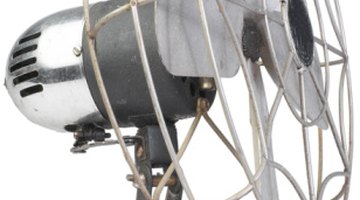Blower vs. Fan
People use blowers and fans for many different types of situations. Blowers, also known as centrifugal fans, are in automobile systems and home heating, ventilating and air-conditioning (HVAC) systems. Fans, also known as axial fans, are in automobile cooling systems and home ventilation systems.

A typical window box fan is an example of an axial fan. Both types have advantages and disadvantages.
Airflow
Axial fans force airflow along the axis of the rotating shaft, which spins the fan. In an airplane, the propeller forces the air from the front of the plane to the back along the sides of the plane. Centrifugal fans pull air in along the axis, but forces it out perpendicular to the axis. If you look at a blower from a car's HVAC system, then you will see that the blower takes air in through the front and sends it out along the sides of the blower.
Power
Axial fans tend to require more power than centrifugal fans. Because these fans are designed for low-pressure, high-volume situations, they require more power to achieve the high rotational speed necessary for normal operation. When you need high efficiency, use centrifugal fans. Centrifugal fans can generate high pressures, but in a more efficient manner than axial fans. For this reason, centrifugal fans are the most used type of industrial fan.
Flexibility
Despite the advantages of a centrifugal fan over a axial fan, axial fans do have some disadvantages. The most important is stall speed. A centrifugal fan alone cannot maintain a constant airflow over a varying flow rate. Another issue with centrifugal fans is maintenance. Because of the positioning of the motor and the fan, it can be difficult or impossible to perform maintenance on the motor without removing the fan unit. This can be very time-consuming.
Noise
If you compare the amount of air moved against the amount of noise the fan or blower makes, then you would find that blowers produce less noise than axial fans of the same size. The reason is the increase in fan speed. Since axial fans have to rotate at a higher speed than a similar-sized centrifugal fan, the axial fan will produce more noise.
References
Writer Bio
William Kinsey lives in Concord, N.C. He started writing articles in March 2009, which have appeared on Autos.com and CarsDirect.com. He currently holds a Bachelor of Science in electrical engineering from the University of North Carolina at Charlotte and a Master of Business Administration from the University of Phoenix. He also has several years experience as an outside plant engineer and planner with AT&T. He also currently owns and operates Sophisticated Curves, an online fashion mall that caters to the needs of plus size women.
Photo Credits
- Hemera Technologies/PhotoObjects.net/Getty Images
- Hemera Technologies/PhotoObjects.net/Getty Images
More Articles



